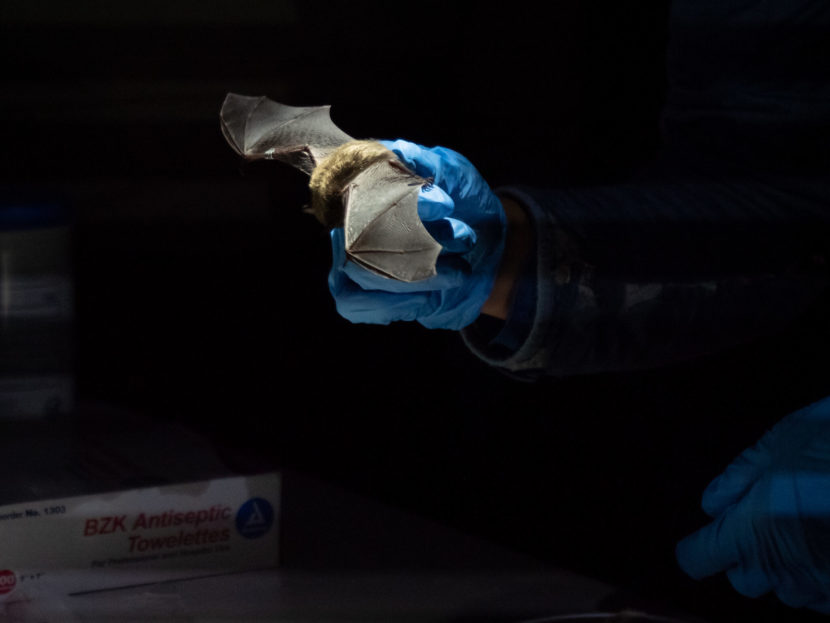
More than 30 people gathered at the Kodiak National Wildlife Refuge’s headquarters near the Buskin River for a Bat Week event. The first bat of the evening made an appearance — a brown myotis, more commonly known as the little brown bat. Little brown bats can live to be 40 years old, and hibernating females give birth to one pup per year.
Among the group gathered to watch them emerge from their roost were researchers who are studying the island’s bat population for the very first time.
Biologist Jesika Reimer caught a female pup with a fine net stretched between two poles. She held it between her latex gloved hands and recorded everything about it — weight, wing length, sex. It was then then banded with an ID number.
“So now we’re going to put her band on, and we basically, we just pop it over her forearm and we squeeze it with our fingers, and it’s tight enough that it’s not going to slip over her wrist or her elbow,” said Reimer. “So, this one is AP-0764. That’s her new name.”
The event was one of four organized through the wildlife refuge and open to the public to watch scientists count and tag the local colony.
Natalie Velez-Suarez is the wildlife refuge specialist for the Kodiak National Wildlife Refuge. She said the list of what they don’t know about Kodiak bats is long — and basic.
“Our biggest question and what we wanted to know is where these bats go during winter and what do they do when we’re not seeing them?” said Velez-Suarez.
Bats play an important role in the ecosystem, according to Reimer. They help control insect populations, and she said Southeast Alaska is home to seven species of bats, and is the state’s hotspot of bat biodiversity.
But there’s less food and habitat further north, making the little brown bat the resident species in the Interior. And Reimer said Kodiak is one big question mark.
“We don’t know if there are more species here,” said Reimer.
Bat studies in Alaska are a burgeoning area of research — largely spearheaded by the Northern Bat Working Group, a coalition of researchers from state and federal agencies and academic programs that formed nearly a decade ago to study bats in Alaska. Group members meet annually to discuss their work.
A big push to understand the species is the spread of a fungal disease called white-nose syndrome that’s decimated bat populations in the Lower 48. The disease has a 90% mortality rate in the little brown bat colonies studied, according to the U.S. Geological Survey. It similarly affects several other species of bat populations native to North America.
Reimer said white-nose syndrome hasn’t arrived in Alaska yet, but it’s a matter of time.
“We know it’s going to arrive here eventually, we’re just not sure how much damage it’s going to do because we don’t know where the bats are spending the winter here,” she said.
That’s why the research happening in Kodiak is so important. Fish and Wildlife staff from other refuges in Alaska were on hand for Bat Week in Kodiak to learn more about bat monitoring. And the Kodiak National Wildlife Refuge plans to expand their monitoring programs to the island’s villages — and enlist any local homeowners who want to help with the count.
Kodiak resident Clara Mieres said it was her 6-year-old son Jackson’s idea to come to the event.
“Bats are super cool, but to him they were always associated with vampires and Halloween and it’s so cool, and here he’s like, ‘We can see them in person?’ And I’m like, ‘Yeah,’ and he’s like ‘Alive bats? We have to do this,'” she said.
Reimer said that excitement could be key for answering bigger questions about the local population. She’ll return to Kodiak next summer to continue gathering data.
